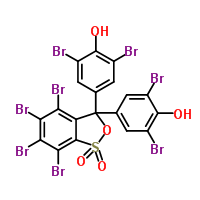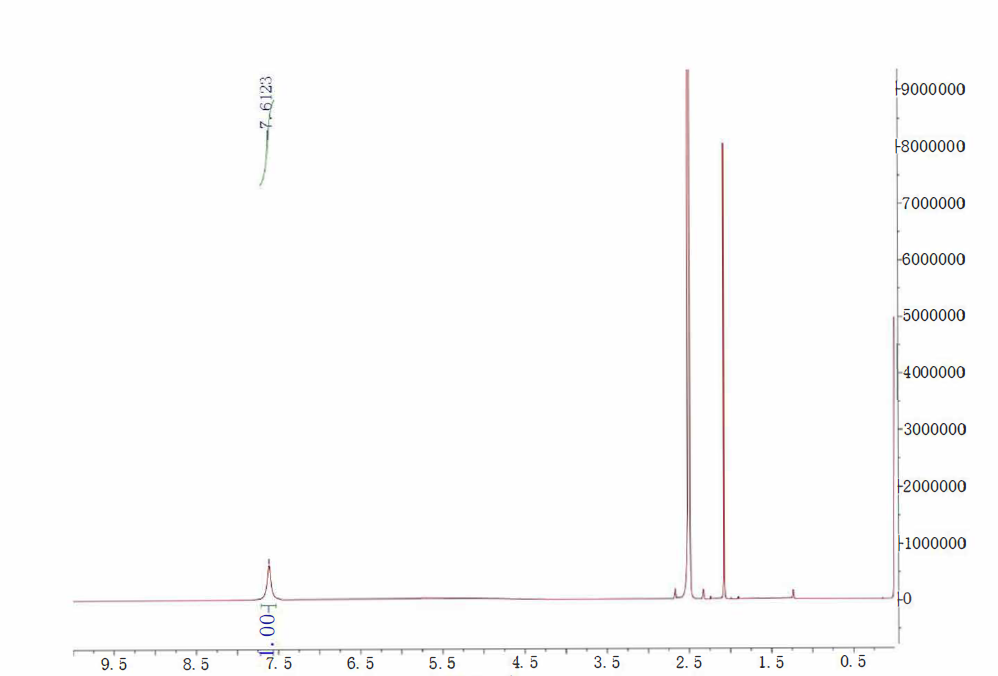Tetrabromophenol Blue CAS#: 4430-25-5; ChemWhat Code: 96491
Identification
| Product Name | Tetrabromophenol Blue |
| IUPAC Name | 2,6-dibromo-4-[4,5,6,7-tetrabromo-3-(3,5-dibromo-4-hydroxyphenyl)-1,1-dioxo-2,1λ6-benzoxathiol-3-yl]phenol |
| Molecular Structure |  |
| CAS Registry Number | 4430-25-5 |
| EINECS Number | 224-622-9 |
| MDL Number | MFCD00005876 |
| Beilstein Registry Number | 378438 |
| Synonyms | 4,4′-(4,5,6,7-tetrabrom-1,1-dioxido-3h-2,1-benzoxathiol-3,3-diyl)bis(2,6-dibrombenzolol) 4,4′-(4,5,6,7-Tetrabrom-1,1-dioxido-3H-2,1-benzoxathiol-3,3-diyl)bis(2,6-dibromphenol) 4,4′-(4,5,6,7-Tetrabromo-1,1-dioxido-3H-2,1-benzoxathiole-3,3-diyl)bis(2,6-dibromophenol) 4,4′-(4,5,6,7-Tétrabromo-1,1-dioxydo-3H-2,1-benzoxathiole-3,3-diyl)bis(2,6-dibromophénol) Phenol, 4,4′-(4,5,6,7-tetrabromo-1,1-dioxido-3H-2,1-benzoxathiol-3-ylidene)bis[2,6-dibromo- 4,4′-(4,5,6,7-tetrabromo-3h-2,1-benzoxathiol-3-ylidene)bis(2,6-dibromophenol) s,s-dioxide 3,3′,3”,4,5,5′,5”,6-Octabromophenolsulfonphthalein 3′,3”,5′,5”-Tetrabromophenol-4,5,6,7-tetrabromosulfonephthalein 3,3-bis(3,5-dibromo-4-hydroxyphenyl)-4,5,6,7-tetrabromobenzo[c]1,2-oxathiolene -1,1-dione 3,3-bis(3,5-dibromo-4-hydroxyphenyl)-4,5,6,7-tetrabromobenzo[c]1,2-oxathiolene-1,1-dione 3,4,5,6,3′,5′,3”,5”-Octabromophenolsulfonphthalein 4,4′-(4,5,6,7-Tetrabromo-3H-2,1-benzoxathiol-3-ylidene)bis(2,6-dibromophenol) S,S-dioxide 4,4′-(4,5,6,7-tetrabromo-3H-2,1-benzoxathiol-3-ylidene)bis[2,6-dibromophenol] S,S-dioxide 4,5,6,7-Tetrabromo-3,3-bis(3,5-dibromo-4-hydroxyphenyl)-2,1λ6-benzoxathiole-1,1(3H)-dione 4,5,6,7-Tetrabromo-3,3-bis(3,5-dibromo-4-hydroxyphenyl)-3H-benzo[c][1,2]oxathiole 1,1-dioxide 4,5,6,7-Tetrabromo-3,3-bis(3,5-dibromo-4-hydroxy-phenyl)-3H-benzo[c][1,2]oxathiole 1,1-dioxide Benzenesulfonic acid, 2-(bis(3,5-dibromo-4-hydroxyphenyl)hydroxymethyl)-3,4,5,6-tetrabromo- (9CI) Tetrabromophenol blue Tetrabromophenyl blue Tetrabromphenol tetrabromsulfonphthalein |
| Molecular Formula | C19H6Br8O5S |
| Molecular Weight | 985.54 |
| InChI | InChI=1S/C19H6Br8O5S/c20-7-1-5(2-8(21)16(7)28)19(6-3-9(22)17(29)10(23)4-6)11-12(24)13(25)14(26)15(27)18(11)33(30,31)32-19/h1-4,28-29H |
| InChI Key | QPMIVFWZGPTDPN-UHFFFAOYSA-N |
| Canonical SMILES | C1=C(C=C(C(=C1Br)O)Br)C2(C3=C(C(=C(C(=C3Br)Br)Br)Br)S(=O)(=O)O2)C4=CC(=C(C(=C4)Br)O)Br |
| Patent Information | ||
| Patent ID | Title | Publication Date |
| CN116375681 | Water-phase synthesis method of tetrabromophenol tetrahalosulfophthalein | 2023 |
| CN116425714 | Preparation method of tetrabromophenol tetrahalosulfophthalein | 2023 |
Physical Data
| Appearance | Light yellow flaky solid |
| Solubility | It is soluble in water as well as soluble in alcohol, benzene. |
| Flash Point | 88 ºC |
| Refractive index | 1.5560 (estimate) |
| Sensitivity | Air Sensitive & Hygroscopic |
| Melting Point, °C | Solvent (Melting Point) |
| acetic acid |
| Dissociation Exponent (pK) | Temperature (Dissociation Exponent), °C | Solvent (Dissociation Exponent) | Method (Dissociation Exponent) |
| 3.52 | 25 | H2O | spectrophotometric |
Spectra
| Description (NMR Spectroscopy) | Nucleus (NMR Spectroscopy) |
| Spectrum | negative secondary ions, positive secondary ions |
| Description (UV/VIS Spectroscopy) | Solvent (UV/VIS Spectroscopy) | Comment (UV/VIS Spectroscopy) | Absorption Maxima (UV/VIS), nm | Ext./Abs. Coefficient, l·mol-1cm-1 |
| Spectrum | benzene | 280 – 570 nm | 5740 | |
| Absorption maxima | H2O | 440, 610 | 8600, 3120 |
Route of Synthesis (ROS)
| Conditions | Yield |
| With lithium bicarbonate In acetonitrile at 45℃; | 85.8 g |
| With sodium hydrogencarbonate In acetonitrile at 55℃; | 2653 g |
| With hydrogen In ethyl acetate under 760.051 Torr; for 2h; Heating; Flow reactor; Green chemistry; | 83.9% |
Safety and Hazards
| Pictogram(s) |  |
| Signal | Danger |
| GHS Hazard Statements | H318 (97.4%): Causes serious eye damage [Danger Serious eye damage/eye irritation] H412 (94.9%): Harmful to aquatic life with long lasting effects [Hazardous to the aquatic environment, long-term hazard] Information may vary between notifications depending on impurities, additives, and other factors. |
| Precautionary Statement Codes | P264+P265, P273, P280, P305+P354+P338, P317, and P501 (The corresponding statement to each P-code can be found at the GHS Classification page.) |
Other Data
| Transportation | NONH for all modes of transport |
| Under the room temperature and away from light | |
| HS Code | 290621 |
| Storage | Store in a cool(2-8 °C) and dry place, and away from light |
| Shelf Life | 2 years |
| Market Price | USD |
| Druglikeness | |
| Lipinski rules component | |
| Molecular Weight | 985.552 |
| logP | 9.386 |
| HBA | 3 |
| HBD | 2 |
| Matching Lipinski Rules | 2 |
| Veber rules component | |
| Polar Surface Area (PSA) | 92.21 |
| Rotatable Bond (RotB) | 2 |
| Matching Veber Rules | 2 |
| Use Pattern |
| Cosmetics/dental/toilet |
| bleaching and coloring composition for fibers in combination with one or more alkalizing agent, one or more bleaching compounds, HC Blue 18 and/or its salt and second aqueous composition containing one or more oxidizing agents |
| bleaching and coloring composition for human hair |
| bleaching and coloring composition for human keratin fibers |
Buy Reagent | |
| No reagent supplier? | Send quick inquiry to ChemWhat |
| Want to be listed here as a reagent supplier? (Paid service) | Click here to contact ChemWhat |
Approved Manufacturers | |
| Caming Pharmaceutical Ltd | http://www.caming.com/ |
| Want to be listed as an approved manufacturer (Requires approvement)? | Please download and fill out this form and send back to approved-manufacturers@chemwhat.com |
Other Suppliers | |
| Watson International Limited | Visit Watson Official Website |
Contact Us for Other Help | |
| Contact us for other information or services | Click here to contact ChemWhat |



